Abstract
Pulmonary mechanics were evaluated in 30 patients with acute myocardial infarction by measuring forced expiratory flow rates and total pulmonary resistance (RT) with the oscillometric method at the resonant frequency of the chest (6-8) cycle/s). During the first 3 days after infarction, forced expiratory volume (FEV) and forced mid-expiratory flow rate (FEF25-75%) were 69% and 60% of predicted values, respectively. 10 or more wk later these values were 95% and 91%. Initially, RT was 52% greater than predicted, but was only 4% greater 10 or more wk later. In 11 patients RT was measured at both resonant frequency and at 3 cycle/s. Five of these patients had no clinical signs of heart failure, but nine had abnormally high values of pulmonary artery pressure, “wedge” pressure and pulmonary extravascular water volume. All of these patients recovered. Initially, RT at resonance was 50% and RT at 3 cycle/s was 130% greater than predicted values. 2-3 wk later these figures were -3% and +6% of those predicted, respectively. At 10 wk or more, significant frequency dependence of RT had disappeared (RT at 3 cycle/s was 7% greater than RT at resonance). Isoproterenol inhalation in six patients caused no change in flow rates, RT at resonance, or RT at 3 cycle/s. RT at resonance and at 3 cycle/s, FEV, and FEF25-75% correlated significantly with the pulmonary vascular pressures. Patients with more marked arterial hypoxia and larger values for extravascular water volume had greater elevations of RT and depression of FEF25-75%, but linear correlations were not significant. Clinical signs of congestive heart failure significantly correlated with a fall in FEV and FEF25-75%, the development of frequency dependence of RT, and elevation of the pulmonary wedge pressure. The initial elevation of RT and low flow rates indicate a modest degree of airway obstruction in acute myocardial infarction. Lack of response to isoproterenol suggests that bronchial muscular constriction is not a major factor. Frequency dependence of RT accompanied by elevated pulmonary vascular pressures and extravascular water volume indicates that pulmonary congestion causes the development of uneven time constants in the airways. Vascular engorgement and interstitial edema from elevated vascular pressures causing narrowing of the peripheral airways and closure of collateral airways could account for the above findings.
Full text
PDF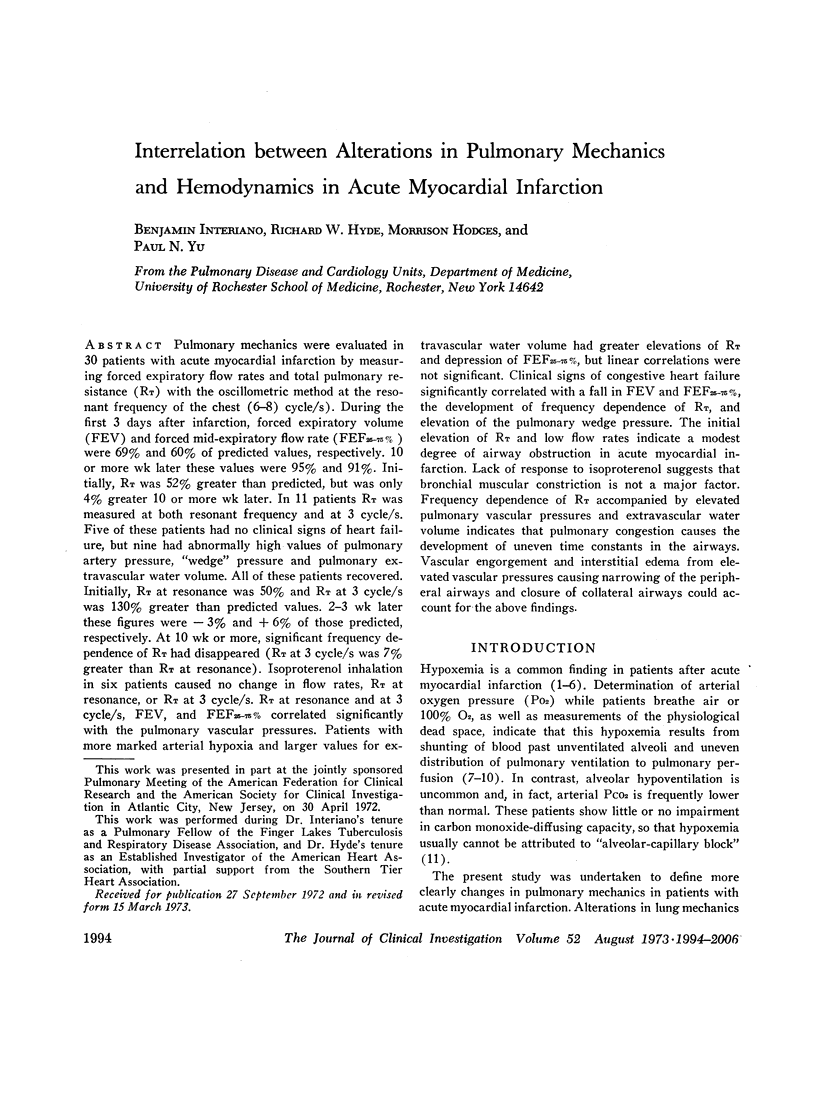
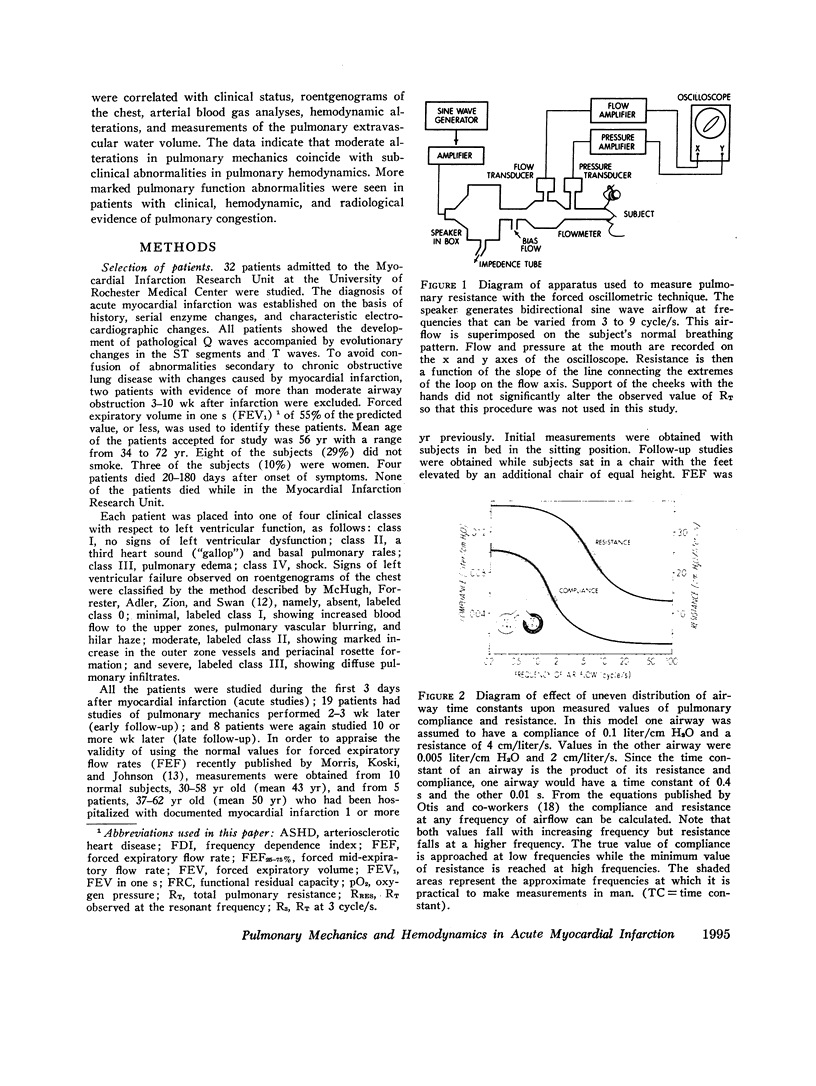
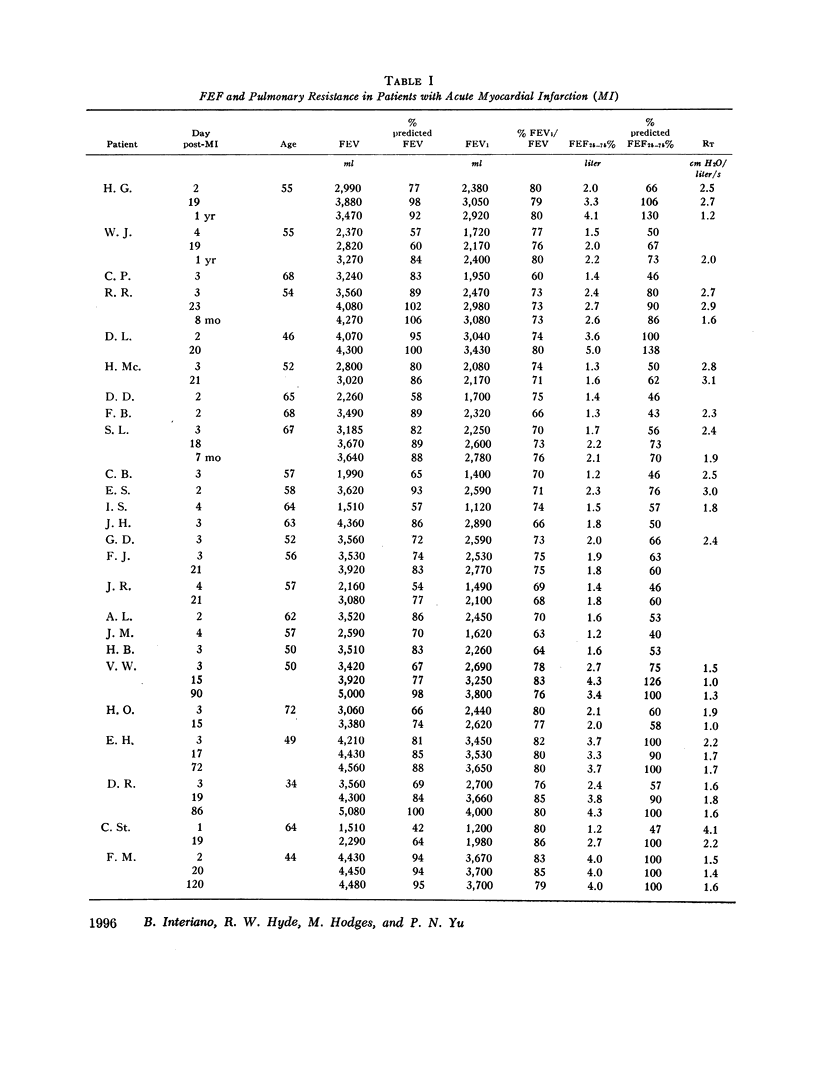
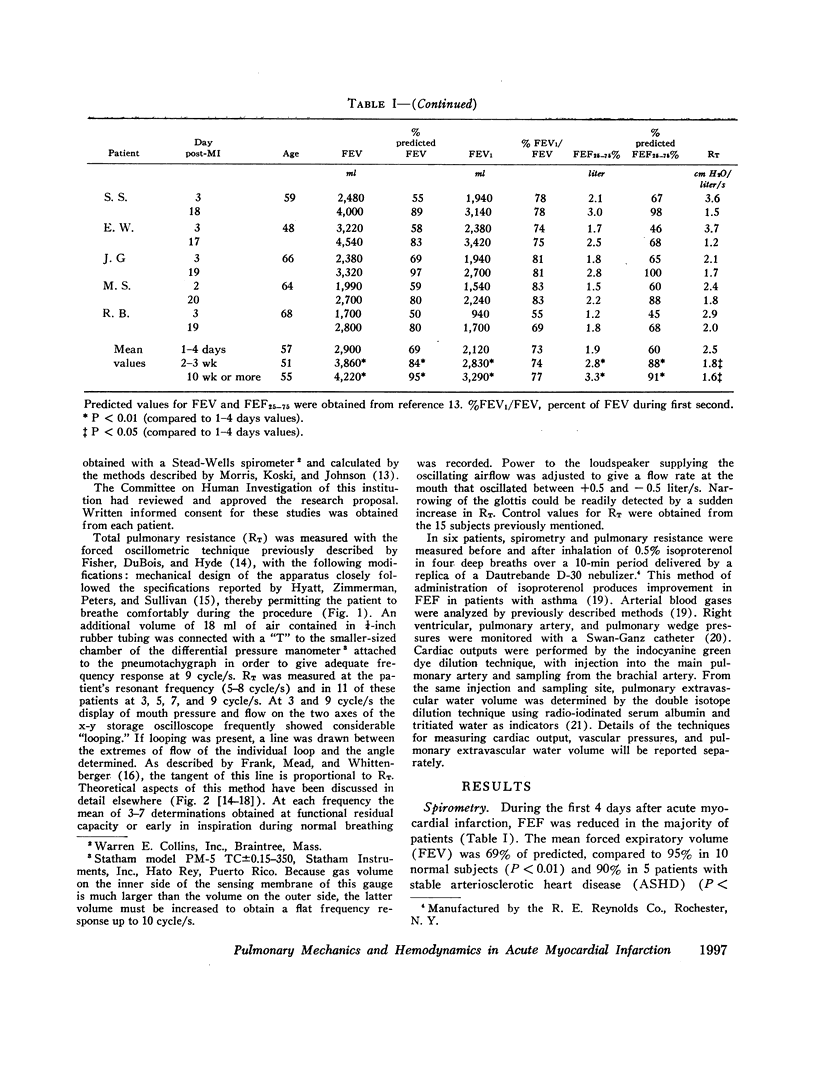
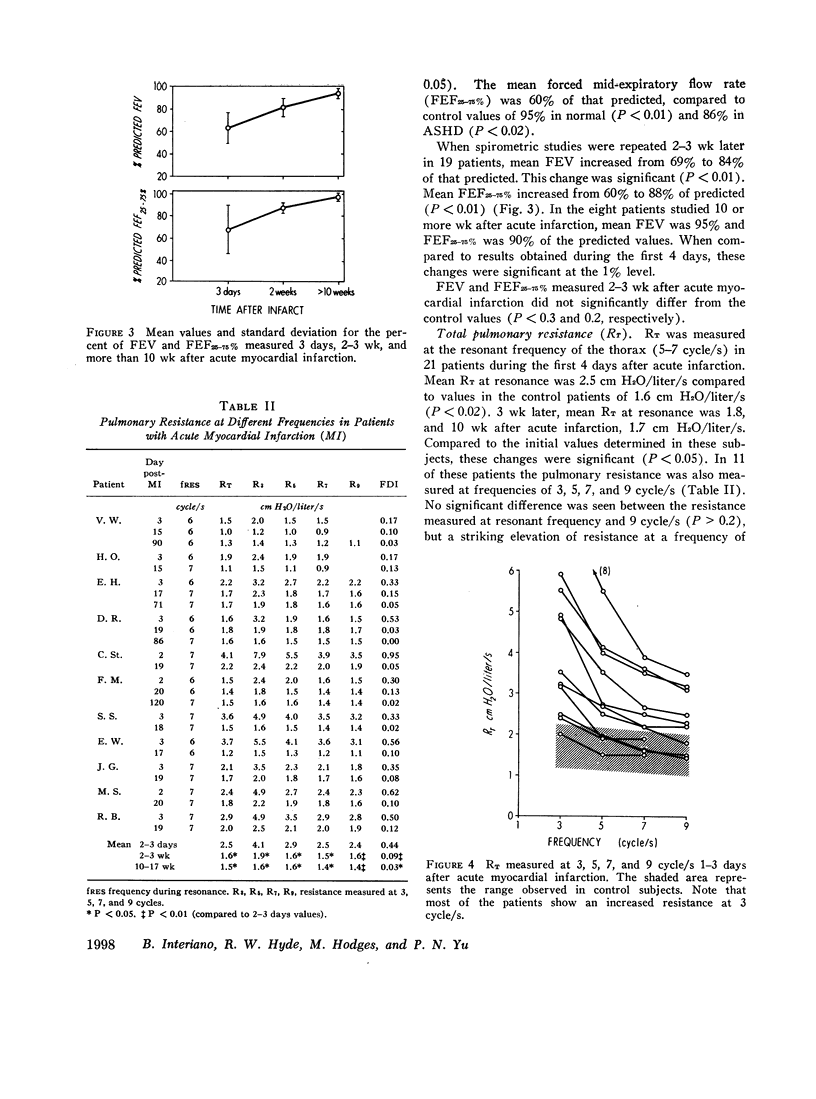
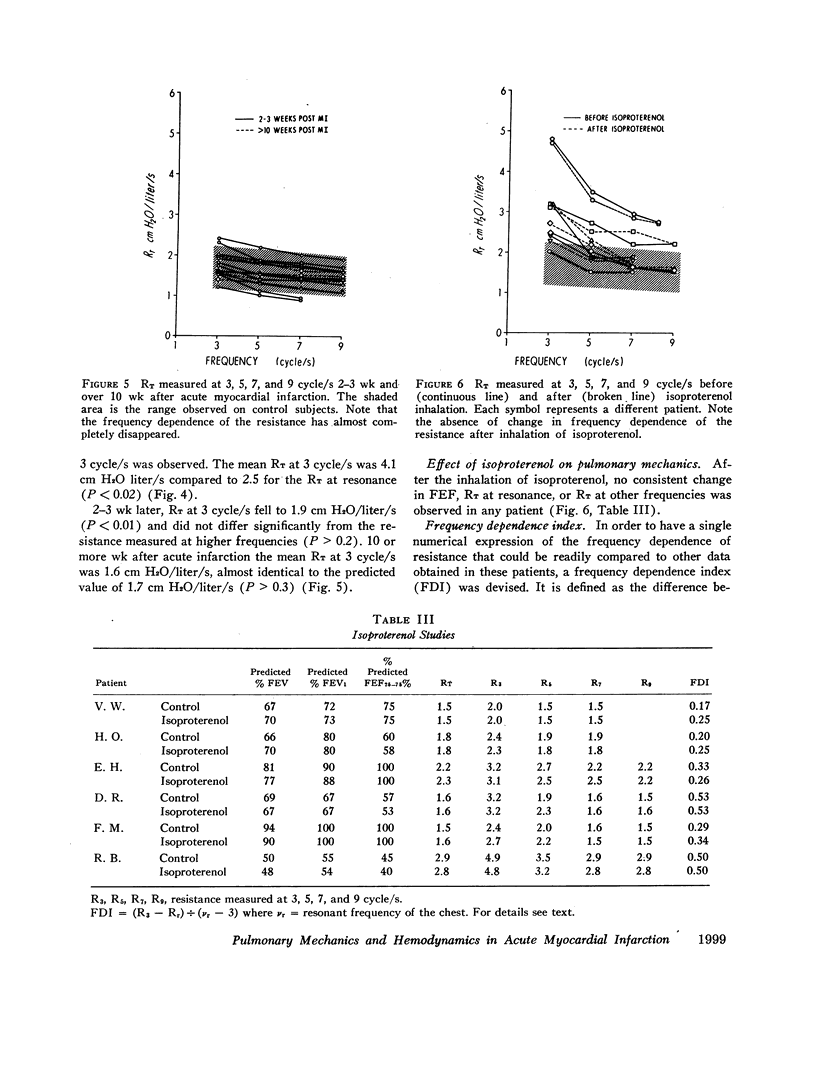
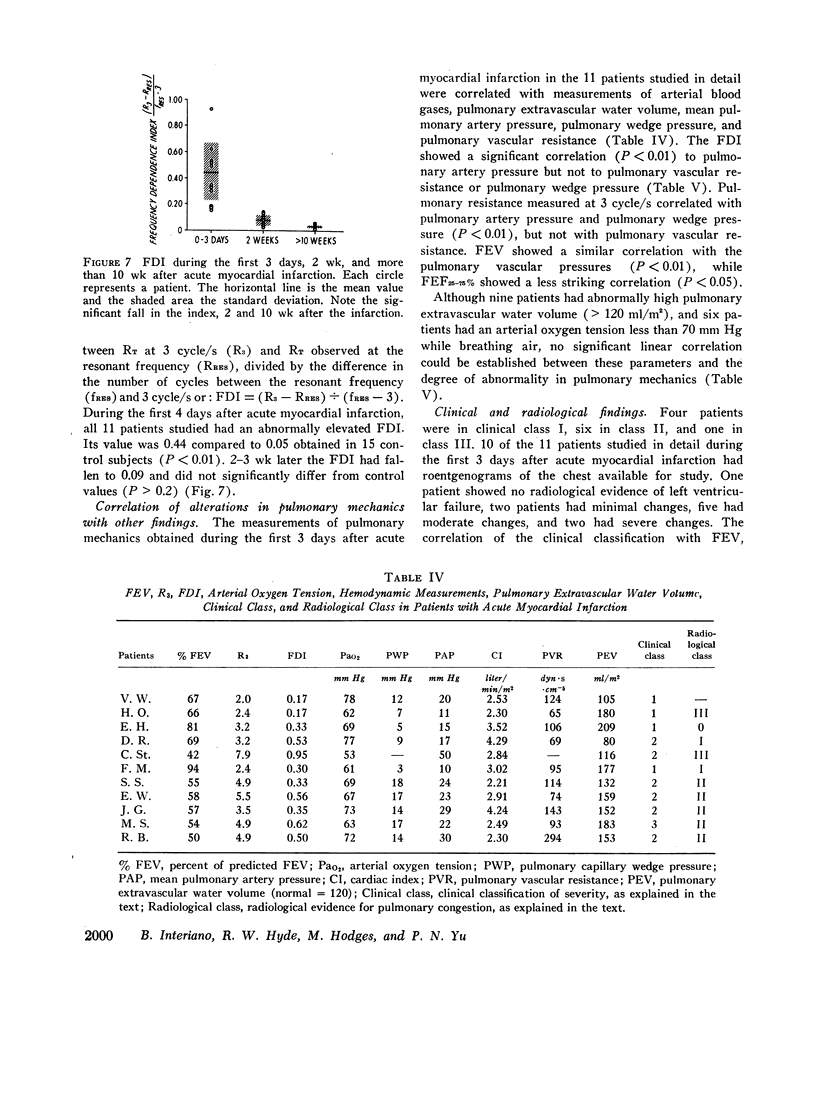
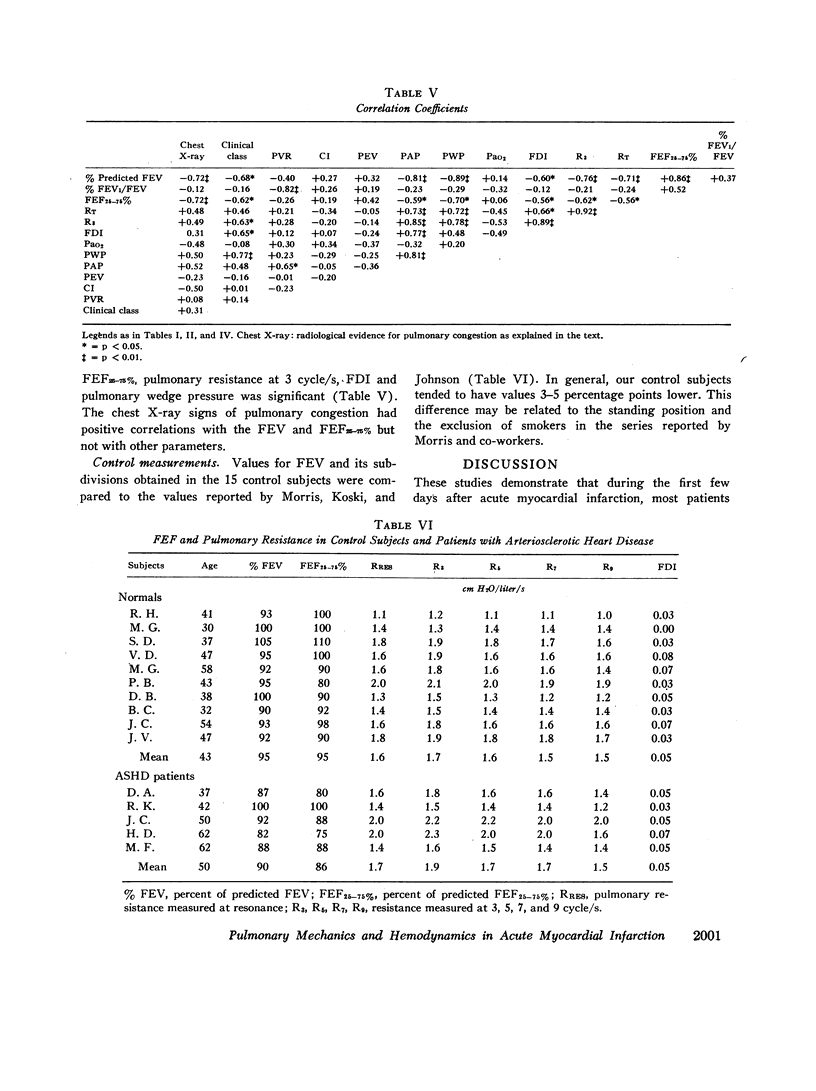
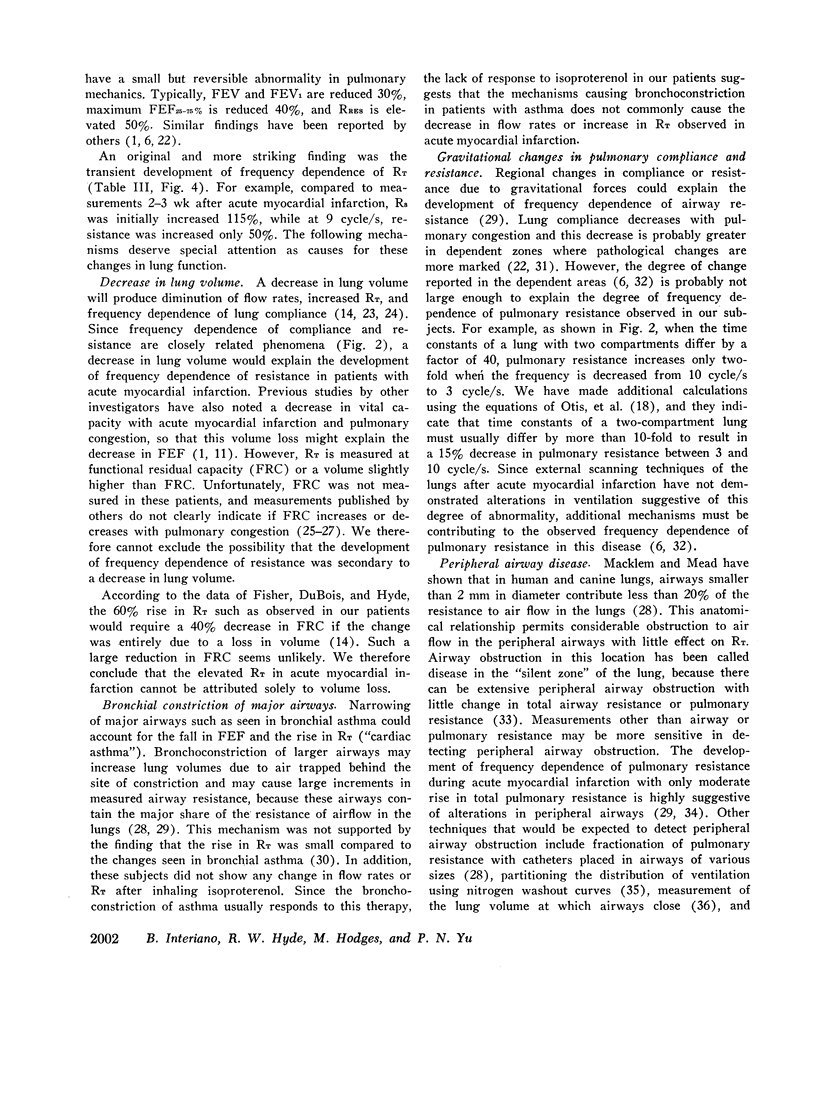
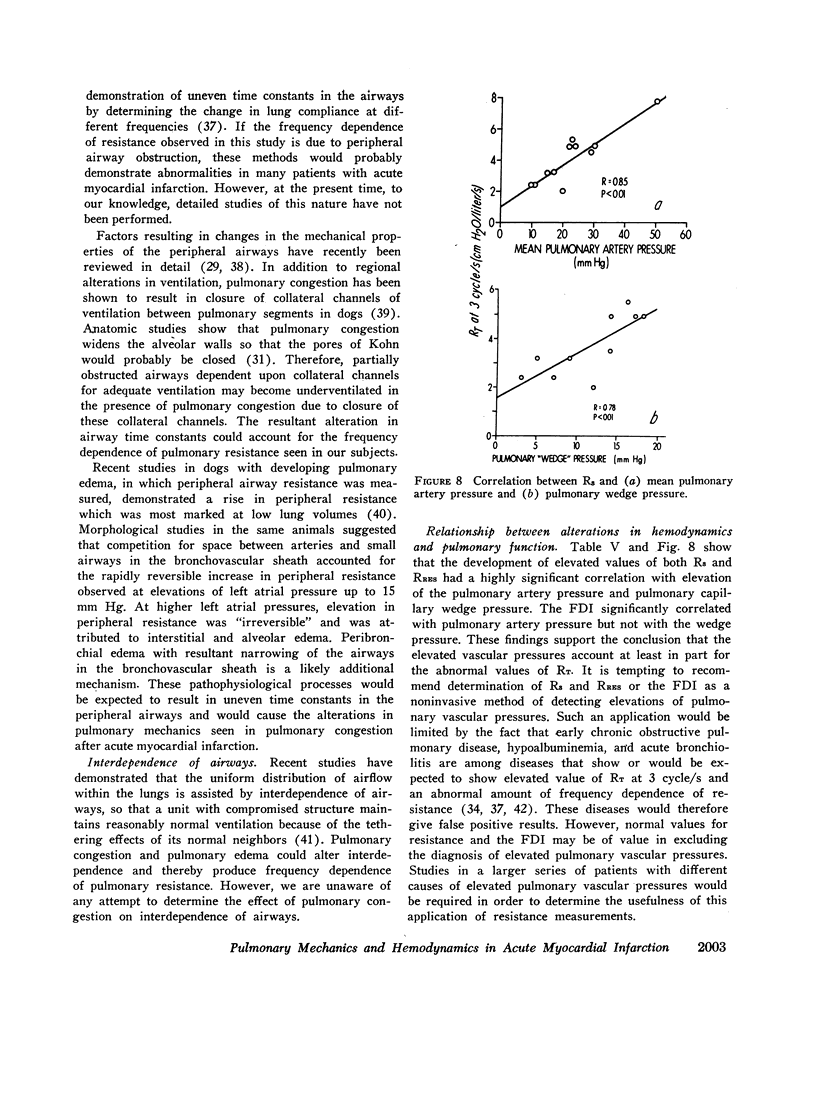
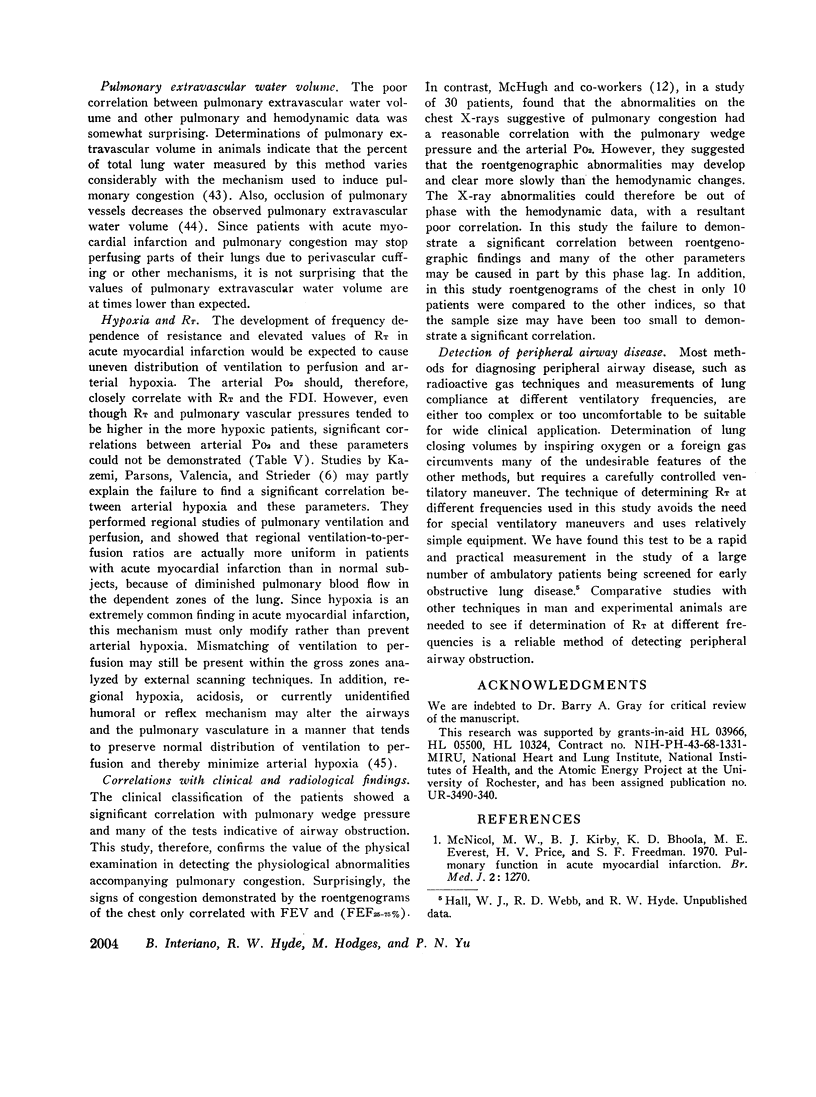

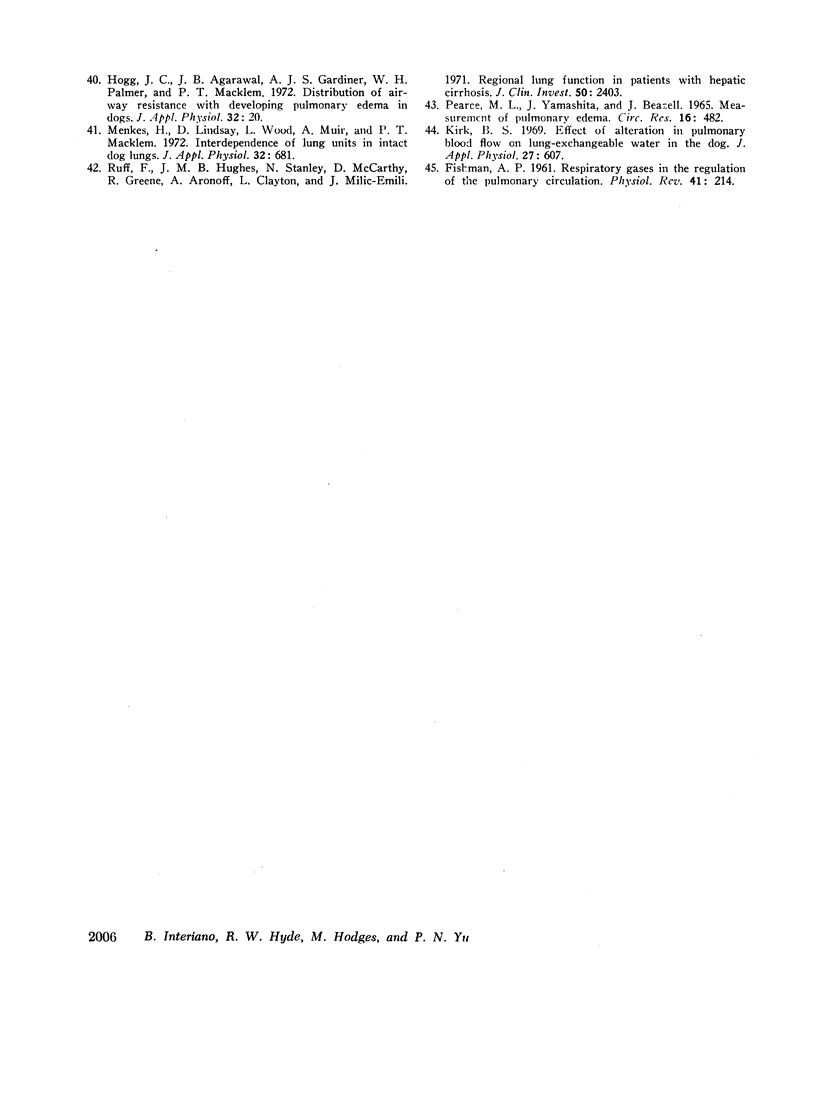
Images in this article
Selected References
These references are in PubMed. This may not be the complete list of references from this article.
- ANKENEY J. L., HUBAY C. A., TILLOTSON F. W. The effect of changes in pulmonary circulation on collateral ventilation. Surg Forum. 1950:25–33. [PubMed] [Google Scholar]
- Anthonisen N. R., Danson J., Robertson P. C., Ross W. R. Airway closure as a function of age. Respir Physiol. 1969 Dec;8(1):58–65. doi: 10.1016/0034-5687(69)90044-9. [DOI] [PubMed] [Google Scholar]
- CHINARD F. P., FLEXNER L. B. Capillary permeability. Bull Johns Hopkins Hosp. 1951 May;88(5):489–492. [PubMed] [Google Scholar]
- FISHMAN A. P. Respiratory gases in the regulation of the pulmonary circulation. Physiol Rev. 1961 Jan;41:214–280. doi: 10.1152/physrev.1961.41.1.214. [DOI] [PubMed] [Google Scholar]
- Fillmore S. J., Shapiro M., Killip T. Arterial oxygen tension in acute myocardial infarction. Serial analysis of clinical state and blood gas changes. Am Heart J. 1970 May;79(5):620–629. doi: 10.1016/0002-8703(70)90281-4. [DOI] [PubMed] [Google Scholar]
- Fisher A. B., DuBois A. B., Hyde R. W. Evaluation of the forced oscillation technique for the determination of resistance to breathing. J Clin Invest. 1968 Sep;47(9):2045–2057. doi: 10.1172/JCI105890. [DOI] [PMC free article] [PubMed] [Google Scholar]
- Frank N. R., Mead J., Whittenberger J. L. Comparative sensitivity of four methods for measuring changes in respiratory flow resistance in man. J Appl Physiol. 1971 Dec;31(6):934–938. doi: 10.1152/jappl.1971.31.6.934. [DOI] [PubMed] [Google Scholar]
- Gazioglu K., Condemi J. J., Hyde R. W., Kaltreider N. L. Effect of isoproterenol on gas exchange during air and oxygen breathing in patients with asthma. Am J Med. 1971 Feb;50(2):185–190. doi: 10.1016/0002-9343(71)90147-1. [DOI] [PubMed] [Google Scholar]
- Goldman M., Knudson R. J., Mead J., Peterson N., Schwaber J. R., Wohl M. E. A simplified measurement of respiratory resistance by forced oscillation. J Appl Physiol. 1970 Jan;28(1):113–116. doi: 10.1152/jappl.1970.28.1.113. [DOI] [PubMed] [Google Scholar]
- Grimby G., Takishima T., Graham W., Macklem P., Mead J. Frequency dependence of flow resistance in patients with obstructive lung disease. J Clin Invest. 1968 Jun;47(6):1455–1465. doi: 10.1172/JCI105837. [DOI] [PMC free article] [PubMed] [Google Scholar]
- Higgs B. E. Factors influencing pulmonary gas exchange during the acute stages of myocardial infarction. Clin Sci. 1968 Aug;35(1):115–122. [PubMed] [Google Scholar]
- Hogg J. C., Agarawal J. B., Gardiner A. J., Palmer W. H., Macklem P. T. Distribution of airway resistance with developing pulmonary edema in dogs. J Appl Physiol. 1972 Jan;32(1):20–24. doi: 10.1152/jappl.1972.32.1.20. [DOI] [PubMed] [Google Scholar]
- Hughes J. M., Glazier J. B., Rosenzweig D. Y., West J. B. Factors determining the distribution of pulmonary blood flow in patients with raised pulmonary venous pressure. Clin Sci. 1969 Dec;37(3):847–858. [PubMed] [Google Scholar]
- Hyatt R. E., Zimmerman I. R., Peters G. M., Sullivan W. J. Direct writeout of total respiratory resistance. J Appl Physiol. 1970 May;28(5):675–678. doi: 10.1152/jappl.1970.28.5.675. [DOI] [PubMed] [Google Scholar]
- Kazemi H., Parsons E. F., Valenca L. M., Strieder D. J. Distribution of pulmonary blood flow after myocardial ischemia and infarction. Circulation. 1970 Jun;41(6):1025–1030. doi: 10.1161/01.cir.41.6.1025. [DOI] [PubMed] [Google Scholar]
- Kirk B. W. Effect of alterations in pulmonary blood flow on lung-exchangeable water in the dog. J Appl Physiol. 1969 Nov;27(5):607–612. doi: 10.1152/jappl.1969.27.5.607. [DOI] [PubMed] [Google Scholar]
- MACKENZIE G. J., FLENLEY D. C., TAYLOR S. H., MCDONALD A. H., STAUNTON H. P., DONALD K. W. CIRCULATORY AND RESPIRATORY STUDIES IN MYOCARDIAL INFARCTION AND CARDIOGENIC SHOCK. Lancet. 1964 Oct 17;2(7364):825–832. doi: 10.1016/s0140-6736(64)90684-1. [DOI] [PubMed] [Google Scholar]
- MILLS R. J., CUMMING G., HARRIS P. FREQUENCY-DEPENDENT COMPLIANCE AT DIFFERENT LEVELS OF INSPIRATION IN NORMAL ADULTS. J Appl Physiol. 1963 Nov;18:1061–1064. doi: 10.1152/jappl.1963.18.6.1061. [DOI] [PubMed] [Google Scholar]
- Macklem P. T. Airway obstruction and collateral ventilation. Physiol Rev. 1971 Apr;51(2):368–436. doi: 10.1152/physrev.1971.51.2.368. [DOI] [PubMed] [Google Scholar]
- Macklem P. T., Mead J. Resistance of central and peripheral airways measured by a retrograde catheter. J Appl Physiol. 1967 Mar;22(3):395–401. doi: 10.1152/jappl.1967.22.3.395. [DOI] [PubMed] [Google Scholar]
- McHugh T. J., Forrester J. S., Adler L., Zion D., Swan H. J. Pulmonary vascular congestion in acute myocardial infarction: hemodynamic and radiologic correlations. Ann Intern Med. 1972 Jan;76(1):29–33. doi: 10.7326/0003-4819-76-1-29. [DOI] [PubMed] [Google Scholar]
- McNicol M. W., Kirby B. J., Bhoola K. D., Everest M. E., Price H. V., Freedman S. F. Pulmonary function in acute myocardial infarction. Br Med J. 1965 Nov 27;2(5473):1270–1273. doi: 10.1136/bmj.2.5473.1270. [DOI] [PMC free article] [PubMed] [Google Scholar]
- McNicol M. W., Kirby B. J., Bhoola K. D., Fulton P. M., Tattersfield A. E. Changes in pulmonary function 6-12 months after recovery from myocardial infarction. Lancet. 1966 Dec 31;2(7479):1441–1443. doi: 10.1016/s0140-6736(66)90598-8. [DOI] [PubMed] [Google Scholar]
- Mead J. The lung's "quiet zone". N Engl J Med. 1970 Jun 4;282(23):1318–1319. doi: 10.1056/NEJM197006042822311. [DOI] [PubMed] [Google Scholar]
- Menkes H., Lindsay D., Wood L., Muir A., Macklem P. T. Interdependence of lung units in intact dog lungs. J Appl Physiol. 1972 May;32(5):681–686. doi: 10.1152/jappl.1972.32.5.681. [DOI] [PubMed] [Google Scholar]
- Milic-Emili J., Ruff F. Effects of pulmonary congestion and edema on the small airways. Bull Physiopathol Respir (Nancy) 1971 Nov-Dec;7(6):1181–1196. [PubMed] [Google Scholar]
- Morris J. F., Koski A., Johnson L. C. Spirometric standards for healthy nonsmoking adults. Am Rev Respir Dis. 1971 Jan;103(1):57–67. doi: 10.1164/arrd.1971.103.1.57. [DOI] [PubMed] [Google Scholar]
- OTIS A. B., MCKERROW C. B., BARTLETT R. A., MEAD J., MCILROY M. B., SELVER-STONE N. J., RADFORD E. P., Jr Mechanical factors in distribution of pulmonary ventilation. J Appl Physiol. 1956 Jan;8(4):427–443. doi: 10.1152/jappl.1956.8.4.427. [DOI] [PubMed] [Google Scholar]
- PEARCE M. L., YAMASHITA J., BEAZELL J. MEASUREMENT OF PULMONARY EDEMA. Circ Res. 1965 May;16:482–488. doi: 10.1161/01.res.16.5.482. [DOI] [PubMed] [Google Scholar]
- Pain M. C., Stannard M., Sloman G. Disturbances of pulmonary function after acute myocardial infarction. Br Med J. 1967 Jun 3;2(5552):591–594. doi: 10.1136/bmj.2.5552.591. [DOI] [PMC free article] [PubMed] [Google Scholar]
- Ruff F., Hughes J. M., Stanley N., McCarthy D., Greene R., Aronoff A., Clayton L., Milic-Emili J. Regional lung function in patients with hepatic cirrhosis. J Clin Invest. 1971 Nov;50(11):2403–2413. doi: 10.1172/JCI106739. [DOI] [PMC free article] [PubMed] [Google Scholar]
- SHARP J. T., GRIFFITH G. T., BUNNELL I. L., GREENE D. G. Ventilatory mechanics in pulmonary edema in man. J Clin Invest. 1958 Jan;37(1):111–117. doi: 10.1172/JCI103577. [DOI] [PMC free article] [PubMed] [Google Scholar]
- Shillingford J. P., Thomas M. Cardiovascular and pulmonary changes in patients with myocardial infarction treated in an intensive care and research unit. Am J Cardiol. 1967 Oct;20(4):484–493. doi: 10.1016/0002-9149(67)90026-4. [DOI] [PubMed] [Google Scholar]
- Staub N. C., Nagano H., Pearce M. L. Pulmonary edema in dogs, especially the sequence of fluid accumulation in lungs. J Appl Physiol. 1967 Feb;22(2):227–240. doi: 10.1152/jappl.1967.22.2.227. [DOI] [PubMed] [Google Scholar]
- Storstein O., Rasmussen K. The cause of arterial hypoxemia in acute myocardial infarction. Acta Med Scand. 1968 Mar;183(3):193–196. doi: 10.1111/j.0954-6820.1968.tb10463.x. [DOI] [PubMed] [Google Scholar]
- Swan H. J., Ganz W., Forrester J., Marcus H., Diamond G., Chonette D. Catheterization of the heart in man with use of a flow-directed balloon-tipped catheter. N Engl J Med. 1970 Aug 27;283(9):447–451. doi: 10.1056/NEJM197008272830902. [DOI] [PubMed] [Google Scholar]
- Valencia A., Burgess J. H. Arterial hypoxemia following acute myocardial infarction. Circulation. 1969 Nov;40(5):641–652. doi: 10.1161/01.cir.40.5.641. [DOI] [PubMed] [Google Scholar]
- Valentine P. A., Fluck D. C., Mounsey J. P., Reid D., Shillingford J. P., Steiner R. E. Blood-gas changes after acute myocardial infarction. Lancet. 1966 Oct 15;2(7468):837–841. doi: 10.1016/s0140-6736(66)92259-8. [DOI] [PubMed] [Google Scholar]
- Woolcock A. J., Vincent N. J., Macklem P. T. Frequency dependence of compliance as a test for obstruction in the small airways. J Clin Invest. 1969 Jun;48(6):1097–1106. doi: 10.1172/JCI106066. [DOI] [PMC free article] [PubMed] [Google Scholar]



